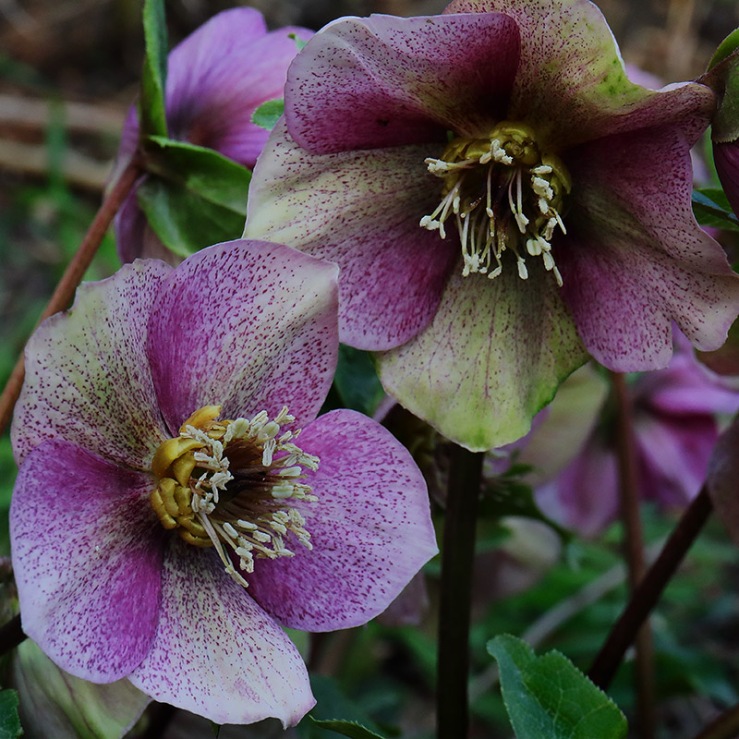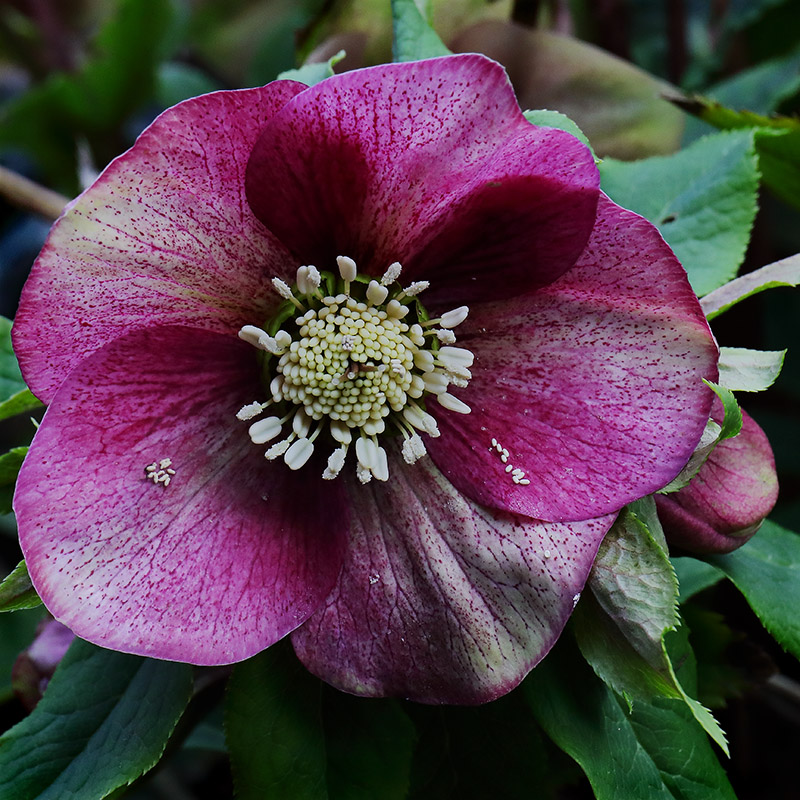NB: A note for WordPress Reader users – you need to click on the title of the post again to see the full photograph. (Otherwise you see just a tiny section!)
Hellebores are resilient plants. They need to be, given that the weather in very early spring can be anywhere between sunshine and gentle breezes to the blast of high winds and freezing rain or snow. This year we’ve had a fairly benign mix – quite a lot of rain but sunshine too and no gales around here.
I did worry that this hellebore and the others that are planted beside it might suffer in the gusts of chilly air that are sent out from the air-source heat pump that we recently had installed. The heat pump works by extracting warmth from the air around it so the air it pushes back out is very cold. Luckily, it turns out that the airstream is just enough to the side of them not to be damaging.
Unfortunately, the site that had to be used for the heat pump meant that a path and a low retaining wall had to be dismantled to make room for it. Now both path and wall will need to be reinstated and the hellebores may be in the way. If possible, I’d rather not move them, especially when they seem happy in their present position. Hopefully, if I do, they’ll survive and bring more joy to next spring.
(Meanwhile, I’m wondering what has laid its eggs on the flower in the top photo…do you see those white ovals? Not slugs or snails, which have round eggs. Not to worry, I suspect the rain we’ve just had will have washed them off!)


Wonderful post ✍️
LikeLiked by 1 person
Thank you – glad you enjoyed it! 🙂
LikeLike
Somehow, I’d never thought of slugs and snails having eggs: round, oval, or square. I felt a little better when I read that land snails tend to bury their eggs underground in a cool, moist place, while saltwater snails lay their eggs behind a rock. However true that is, it would help to explain why I’ve never seen any, although it’s also true that I rarely see a snail of any sort. Have you ever seen Japanese beetles around your garden? A number of sites say that their eggs are white and oval, although I’m sure other insects could produce them.
I hope the Hellebores can stay put. Having to move well-adapted plants always is a little sad.
LikeLiked by 1 person
I’ve never seen a Japanese beetle and I don’t think they’re a problem in the UK yet…! But maybe they were laid by another beetle.
LikeLiked by 1 person
It’s nice to know that some of your flowers have weathered the winter, Ann. The flower details are beautiful. I hope you will not have to remove them from their appointed spot, or if you do, that they will transplant well.
LikeLiked by 1 person
Thanks Tanja! They are tough plants, so manage to cope with a lot but I don’t know how well they fare if moved. I’ll have to see if the layout of the wall can be manipulated a bit to let them stay where they are…eek!
LikeLiked by 1 person
Another garden project for you–and one you might have wanted to do without!
LikeLiked by 1 person
Thanks for sharing this idea with thecwet Spring. Anita
LikeLiked by 1 person
Thank you Anita! 🙂
LikeLike
I looked up hellebores and found they’re members of the buttercup family. The name needed some explaining, too. The American Heritage Dictionary gives this etymology: “Middle English ellebre, from Old French, from Latin elleborus, from Greek helleboros : perhaps hellos, fawn + -boros, eaten (from bibrōskein, to eat).”
If you wait you may learn what kind of eggs those are.
LikeLiked by 1 person
Glamourous buttercups! Probably a good thing that we don’t get deer in gardens here… 🙂 I’ll keep a lookout to see if I can spot those eggs hatching but I suspect the rain may have washed them away by now.
LikeLike
Sharp and clear pics, Ann!
LikeLiked by 1 person
Thank you Indira! 🙂
LikeLiked by 1 person
That hellebore is simply stunning. Had to look again to see the eggs.
LikeLiked by 1 person
Thanks Jill! The hellebores have done really well this year, with lots of flowers. I should really pick some so that I can photograph them indoors but I’m distracted by all of the work that’s waiting in the garden! 🙂
LikeLike
I have a white hellebore which has seeded itself in my flowering currant.
LikeLiked by 1 person
Lovely – I wish mine would seed themselves! (I had to remove other plants from around mine, so may have lost any seedlings that were trying to grow. Maybe there will be some in future…)
LikeLiked by 1 person
Beautiful flowers, harbingers of spring…I hope!
LikeLiked by 1 person
I hope so too! It is starting to feel a bit more spring-y, despite a old night last night. I’m certainly looking forward to the weather getting a bit warmer!
LikeLiked by 1 person
Your Hellebore flower is one of if not the prettiest I’ve seen!
LikeLiked by 1 person
Thank you for the lovely comment – you’ve made me smile! 🙂
LikeLiked by 1 person